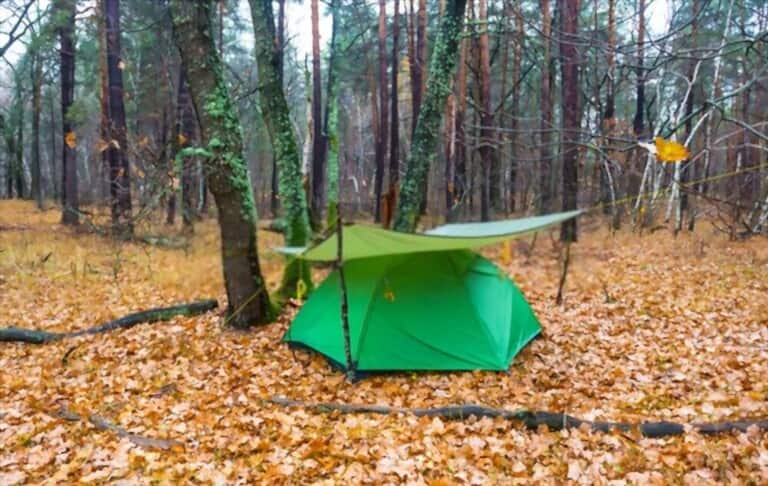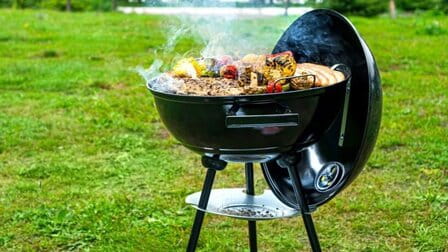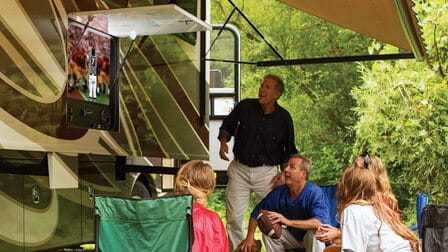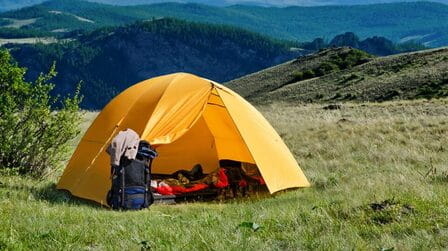One of the most practical items you can have in your bag is a camping tarp. They do lack the enchantment and "wow" aspect that tools and technology provide and aren't exactly glamourous. They are only tarps. How intriguing might that be? Well, the modest camping tarp may bring you closer to nature than any other sleeping arrangement in a world of high-tech camping tents and contemporary RVs. And here are some steps on the list of how to set up a camping tarp.
What is A Tarp?
In essence, it's a waterproof single-skin sheet that's used to build custom shelters. Using pegs, guylines, walking poles, and optional groundsheets or insect nets, it may be arranged in a variety of forms and configurations. With such adaptability, the weather may be changed: in calm weather, pitch high for room, ventilation, and epic vistas; in stormy weather, pitch low for stability and protection.
Therefore, choosing a tarp over a tent won't always subject you to greater wind and precipitation. You may rapidly become adept at pitching your tarp such that it will keep you dry in the mountains come rain or sun with a little practice. There are several alternatives, ranging from the straightforward A-Frame and Lean-To to the trickier Tipi or C Fly Wedge.
How to Set Up a Camping Tarp
One of the most useful and adaptable pieces of equipment you can have is a lightweight tarp, provided you know how to use it. It allows you to sleep outside in the bush, is lighter than a tent, and goes up more quickly if you are caught in an unexpected deluge. The best advice we can give you is to practice, practice, practice pitching your tarp! So, no matter the weather or where you are, you can quickly set up a safe and comfortable shelter. Besides that, you can reference from the list how to set up a camping tarp.
Do a proper ground test
Choosing the ground test is the first step on the list of how to set up a camping tarp. The majority of inexperienced tarp campers will select what appears to be flat ground and start setting it up without first checking it. You should really lie down and test the precise area you wish to lie in your sleeping bag before deciding where to build up a tarp shelter.

By experimenting with various angles and positions, you can usually find yourself a lovely groove for your hips and a flat space for your back. If you are setting up in the dark, tree roots and rocks may not always be evident, but checking the ground will.
You should examine the ground for wetness in addition to looking for lumps and bumps. You should stay away from damp patches of moss where surface water flows if you're camping on a mountain.
Windowmakers in oid
Windowmakers are dead tree branches that could fall during the night and hurt you terribly. Although some tree species are more likely to lose their limbs, you should always check above for potentially dangerous branches before you consider setting up.

You must take extra caution to ensure that your body weight doesn't shake any branches higher up if you are tarp camping with a hammock. If the wind increases up, the stress may force smaller trees inward, which may fracture a limb or possibly the trunk. For this reason, search for strong, healthy trees with a thick trunk and no hanging dead limbs.
Don't set up a tarp next to the water
The lack of insect protection provided by tarp camping without the use of a separate mosquito net is one of its main disadvantages. You should stay away from that attractive area near a still lake or stream since it serves as a real breeding ground for biting insects.

When mosquito larvae spawn, they are hungry and on the hunt for blood. You better believe you will be bothered by them all night if you are the first piece of flesh they see.
Tarp camping adjacent to a stream or river might be risky depending on the location if the region is prone to flash floods and a rising water level. After a night of bug bites, the last thing you want is to be awakened in the middle of the night by rising water.
Verify the wind's direction and pitch as necessary
Verifying the wind’s direction is important on the list of how to set up a camping tarp. Have a look around to see if there is a position that will naturally shield the wind from your tarp before even deciding on a site to lay up your tarp. This might be tucked away behind some vegetation or a hill of dirt where the wind is diverted, and you can sleep more soundly.

If you are unable to choose a location that is wind-sheltered, then consider carefully the direction to pitch your roof. Lean-to shelters generate some noise when they flap around, but they are great for deflecting wind that is blowing in one direction.
Pitched roofs will offer shelter from two sides, but they also form a tunnel that runs the length of the building, which may channel wind and make for a chilly night's sleep. In windy conditions, pitching low to the ground with an aerodynamic form that is fastened as tautly as possible to minimize flapping is the greatest thing you can do.
Reducing Biting Insects by pitching in the wind
If the biting insects are out in force, you should think about pitching in an open area while it's breezy. Because their small wings can't compete with it, even a light wind can prevent bugs from swarming above your head.
Because it is too windy and chilly for the pests to become an issue, a lot of people like camping on top of mountain tops in the summer. Although we still advise pitching with your roof in the wind's direction, the wind might occasionally work to your benefit.
Walking sticks
Anytime you can bring a piece of equipment that is versatile and will probably be used frequently, you are winning. In addition to making excellent tarp poles, hiking poles are an excellent walking assistance for steep ascents, descents, and long distances.
You will need some sort of solid pole to support up the roof if there are no trees or other structures to hang your tarp from along the ridge. For this, hiking poles are the ideal length and form. They also contain a spike that can be driven into the ground for further security.
Guylines are required to create the tension necessary to maintain the pole in an upright position while utilizing hiking poles. You pull the pole in opposing directions to make a strong pole that won't topple over by using the tension produced by pegging the tarp out and the pressure from the guylines.
Conclusion
The chance of suffering a major injury is higher during several outdoor activities. Extensive survival supplies, such as food, water, maps, protective clothes, and first aid, as well as mental and physical toughness, are needed in wilderness situations. This page is meant to be instructive and informative; it does not replace formal education or professional training. Hope that you will enjoy the list of how to set up a camping tarp.













